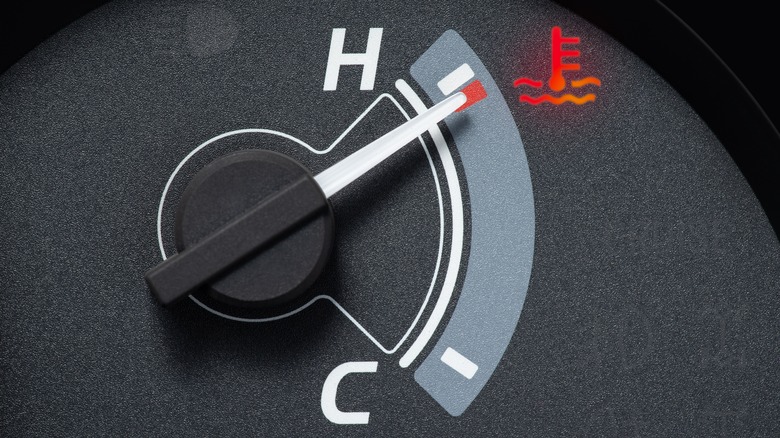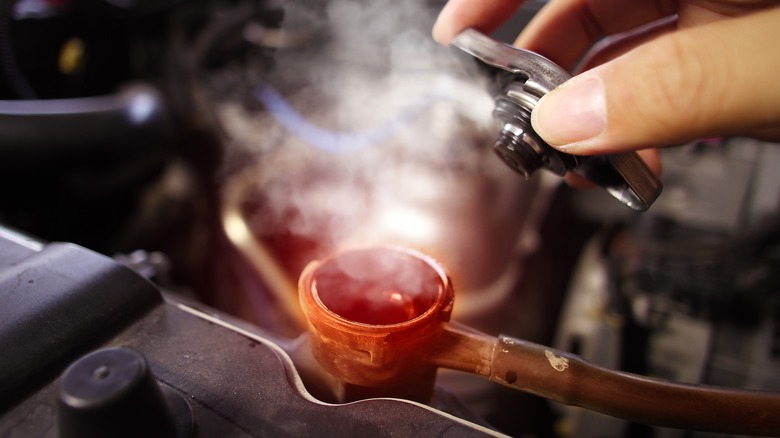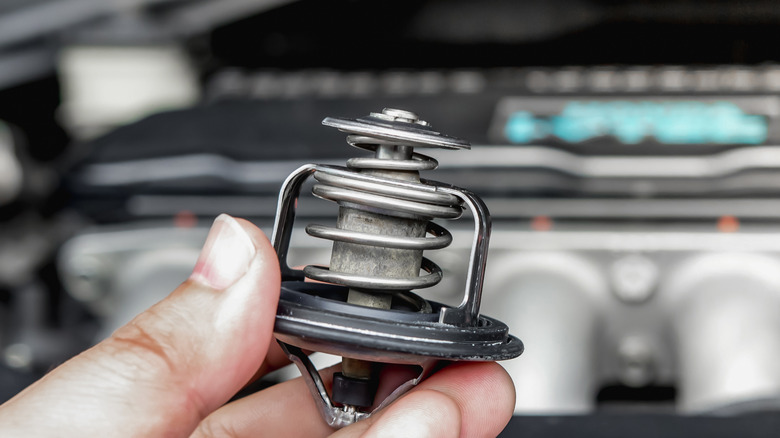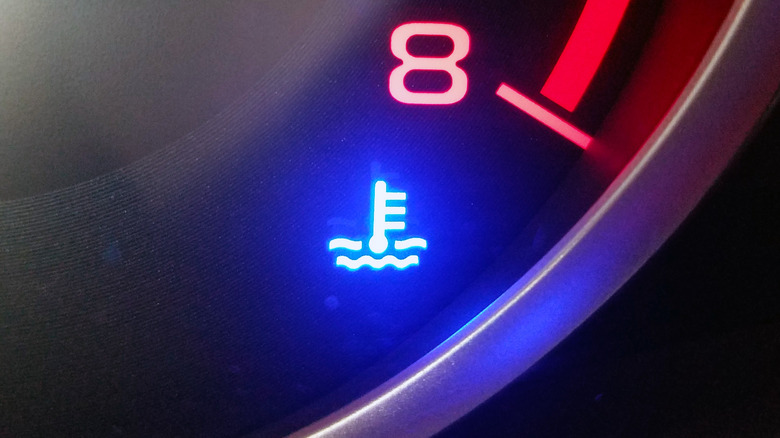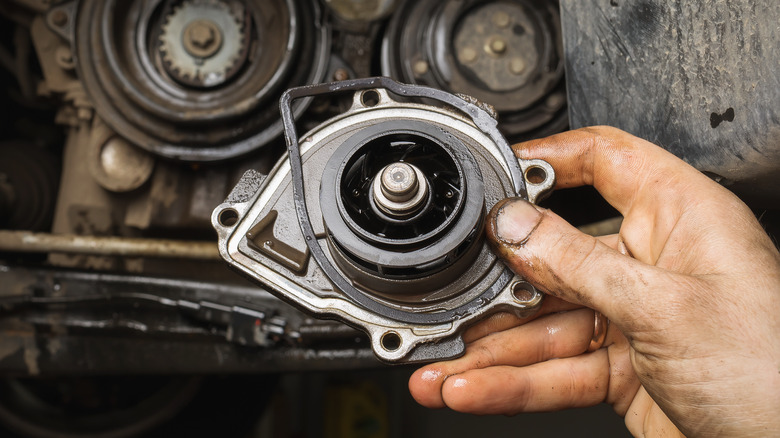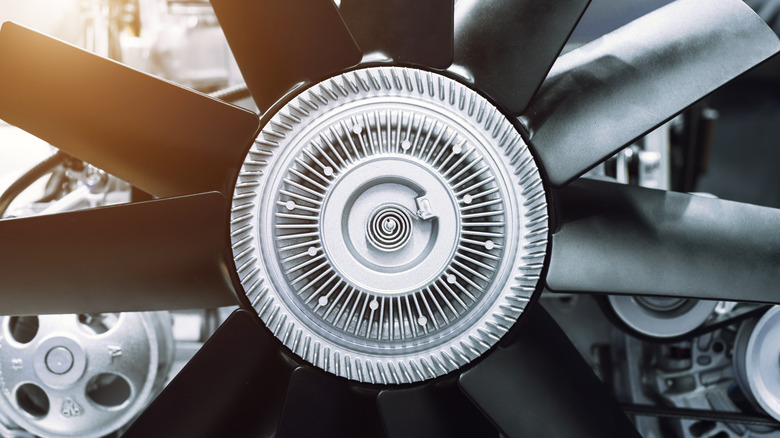5 Reasons Why Your Engine Temperature Warning Light May Be On
Most automobile owners can agree that there is never a good time to see any of a vehicle's various warning lights pop up on the dashboard. That said, they'd likely all agree that they're thankful those lights exist, because each one is designed to alert motorists to potential issues with their vehicle. As for the near existential dread those warnings tend to inspire in drivers, it's because said lights tend to signal a pricey trip to a mechanic is in their future.
If the illuminated light is the one declaring that your engine is running hot, there are just not that many ideal outcomes for an overheated engine. When that light ticks on, you'd be wise not to ignore it and get your vehicle to a mechanic as soon as possible, because a failure to do so will almost certainly lead to further, potentially catastrophic damage to the engine of your car, truck, or SUV.
If you aren't near a garage when your temperature warning light does tick on, one of the first things you should do is pull safely off the road and let the engine cool down. It may even be wise to call a tow truck to take you to the nearest mechanic. Once there, you'll likely learn that one of the following culprits led to your vehicle's engine temperature warning light.
Radiator failure
We're gonna kick off the conversation with your engine's radiator, because when it comes to worst-case scenarios, "radiator failure" is at the top of the list of things you do not want to hear your mechanic say. The radiator is, in essence, your engine's primary defense system against running hot.
If you're unfamiliar with what your radiator is tasked with doing under the hood, the system is primarily charged with ferrying a mixture of coolant and water into the engine. There, the mixture absorbs heat and is ushered back into the radiator where a barrage of thin metallic "fins" helps dissipate the heat from the mixture. There are several factors that could contribute to radiator failure, including damaged fins, corrosion, faulty pump, and, of course, a lack of coolant, among others. If any one of those components fails, the whole radiator system may follow, and that could not only lead to an overheat, or even engine failure if repairs are not made.
It should go without saying, but radiator repairs are not cheap, with costs ranging from anywhere between a few hundred bucks, to more than $1,000 on parts alone. Repair costs will depend on factors like the make and model of your vehicle and which components need replacing. As costly as radiator repairs can be, they pale in comparison to those you'll face if your vehicle's engine fails completely, so try to fix the issues before damage is done.
Malfunctioning thermostat
The radiator is arguably the most important component in your vehicle's engine cooling system, but it is far from the only one that can contribute to an overheat when not functioning properly. Another one of those vital cooling components is the thermostat, which is primarily responsible for controlling the flow of coolant into the engine.
As far as how the thermostat achieves that function, it does so by monitoring the engine's temperature and — when the engine starts to get hot — opens up to allow coolant in. Likewise, when the engine is cold, the thermostat remains closed, thus preventing the injection of unnecessary coolant. In the latter case, it can be difficult for a vehicle to warm up to its ideal operating temperature. However, the former issue is even more dangerous, as it will eventually result in an engine overheat which can result in catastrophic engine failure.
Should you need to take your overheating car to a mechanic, odds are the thermostat is among the first components they'll check when trying to diagnose the problem. If you're lucky, the damaged thermostat is the only issue the mechanic will find, though replacing one will likely cost you around $700 on average. The good news is that a new thermostat should be good for roughly a decade, or 100,000 miles — whichever comes first.
Low or leaking coolant
In that same vein, it's vital it is that you actually have the correct amount of coolant in your engine at all times, because having too little is one of the fastest ways to ensure said engine will eventually overheat and trigger that dreaded temperature warning light.
If you know how to take proper long-term care of your vehicle, you know it should never operate without enough coolant. It's one of those fluids that should be checked at least as often as you get the oil changed, though some recommend weekly inspections just to be safe. More than that, coolant levels are easy enough to check without the aid of an automotive professional. After all, the coolant reservoir tends to be both visible and accessible to owners when the hood is raised on their vehicle. Engine coolants can be purchased through automotive chains and retail outlets for under $20.
Even if you are comfortable topping off the fluids in your vehicle sans professional help, if the problem persists, you will need to surmise exactly what is leading to the lack of coolant in your system. Leaking hoses and other costly failures may be the problem. If that's the case, you'll likely need to pay a pro to make the necessary repairs.
Bad water pump
With the thermostat controlling when to release coolant into the engine, and the radiator primarily tasked with transporting the vital liquid to the necessary components, the question of how the fluid begins that journey is important. It is, in fact, the job of a good old-fashioned water pump to ensure that coolant is properly churning through the radiator, and thus being spread out through those engine components that are prone to running hot.
Without a properly functioning water pump, an overheated engine is all but guaranteed, as the engine-preserving coolant will sit undisturbed in its reservoir rather than performing its essential function under the hood. Though some newer model cars have water pumps powered by electrical systems, many are still reliant on a timing belt to function properly, and if that belt fails, it could lead the pump to do the same.
Even as modern water pumps are built to last close to 100,000 miles, there are no guarantees that the pump itself won't malfunction prematurely, as is the case with virtually any engine component. Unfortunately, there's not much you can do to preserve the life of your vehicle's water pump. But you can keep an eye out for warning signs your pump is having problems, including the puddling of coolant or water under your vehicle, or grinding sounds in the engine that signal the degradation of that belt. Should that pump need replacing, you can expect the repairs to cost upwards of $900 or more.
Broken cooling fan
If your vehicle is overheating, it's possible you've got a bum engine fan on your hands as well. That component is often referred to as the radiator fan, as it is located between the radiator and the engine. Its primary goal is to cool both radiator and engine by pulling air through the grille of the vehicle when it isn't moving fast enough to pull enough through itself. As is the case with a car's water pump, radiator fans can either be electrical or belt-driven these days, and depending on the design of your car's engine, there may be more than one fan doing the job.
Whatever the case, an engine overheat is very possible when a fan isn't functioning as it should. Just like many of the other failures that can lead to the temperature warning light turning on, repairing or replacing a radiator fan can get pricey. The part itself can cost anywhere from $50 to $500, with labor potentially doubling that cost. Even still, that cost is modest in comparison to replacing a blown engine, so best to get the fan repair/replaced as soon as possible.
